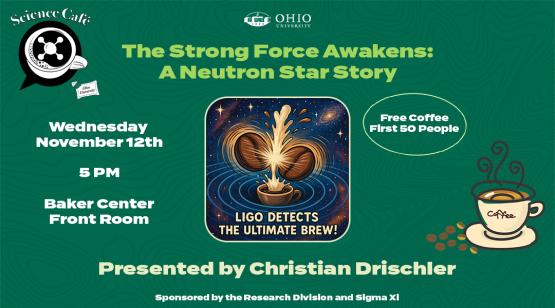Students studying physics and astronomy at OHIO get the experience they need to succeed in careers in science and technology, business and industry, government and public affairs—and even careers of the future that don't exist yet.
Physics & Astronomy Department
Ranked Among the Best Global Universities for Physics
Ohio University is ranked among the Best Global Universities by U.S. News & World Report, with its physics program among the best in the world. Students explore yesterday, today and tomorrow in search of a deeper understanding of the natural world—from the mysteries of dark matter to the smallest machines possible, from the complexity of life to nature's strongest forces.
Explorations from Nano-Particles to the Stars
Our faculty and students leave a global footprint at national labs and research facilities around the world.
They recently took the world's first X-ray of a single atom, helped DESI make the largest 3D map of our universe, and raced the world's tiniest monster truck made of just a few molecules.
Faculty Research Areas
Prospective graduate students or undergraduates interested in getting involved in research can explore our faculty research areas to find faculty working in areas that interest them.
Facilities & Labs
Our researchers take advantage of the Edwards Accelerator Laboratory, Scanning Tunneling Microscopy, femtosecond lasers, and much more.
Centers & Institutes
Our students get hands-on experience working with faculty in the Astrophysical Institute, the Institute of Nuclear and Particle Physics, and the Institute of Nuclear and Particle Physics.
Research Areas We Focus On
-
Astrophysics & Cosmology ResearchFrom the mysteries of dark matter to the secrets hidden in our own solar system, astrophysics probes the universe of unanswered questions.
-
Nanoscience, Condensed Matter and Surface Science Physics ResearchAt the size scale of at atom, researchers manipulate nano-particles to explore the world of quantum mechanics and to build the smallest machines possible.
-
Biophysics ResearchBiophysicists study the complexity of life by using the laws of physics and the power of math to analyze patterns in living things, from epilepsy to signal processing.
-
Nuclear and Particle Physics ResearchThe nuclear force is the strongest found in nature. From questions of how protons and neutrons are bound in nuclei (or neutron stars) to the interactions of quarks and gluons, this is strong stuff.
OHIO Researchers Demonstrate Tunable Superconductivity
Julie Roche Named American Physical Society Fellow
Oxford, OHIO Researchers Reveal Amorphous Silicon 'in Exquisite Detail'
Universe Might Be Changing: New DESI Data Shows Dark Energy May Evolve Over Time
Physics & Astronomy Student Experiences — Here and Abroad
In the accelerator field. Around the world. Just a few places you might get hands-on physics and astronomy experience.
-
Greta Hibbard Won a Prestigious Goldwater ScholarshipGreta Hibbard worked at the Princeton Plasma Physics Laboratory to create a new machine learning algorithm for fusion reactor optimization.
-
Sneha Upadhyay Unravels Big Mysteries with Tiny ParticlesSneha Upadhyay takes an award-winning approach to quantum research in the the Low Temperature/Variable Temperature-Spin Polarized Scanning Tunneling Microscopy-Molecular Beam Epitaxy lab.
-
Get Research Experience in OHIO's AcceleratorBoth undergraduate and graduate students can get hands-on experience in the Edwards Accelerator Lab,
-
Take Advantage of a Paid IntershipMany of our undergraduate students qualify for paid internships and get to help in our labs at OHIO or in labs around the world.




